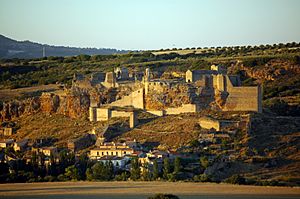Castle of Zorita de los Canes-Alcazaba de Zorita facts for kids
Quick facts for kids Castle of Zorita de los Canes-Alcazaba de Zorita |
|
|---|---|
| Native name Spanish: Castillo de Zorita de los Canes-Alcazaba de Zorita |
|
 |
|
| Location | Zorita de los Canes, Spain |
| Official name: Castillo de Zorita de los Canes-Alcazaba de Zorita | |
| Type | Non-movable |
| Criteria | Monument |
| Designated | 1931 |
| Reference no. | RI-51-0000611 |
| Lua error in Module:Location_map at line 420: attempt to index field 'wikibase' (a nil value). | |
The Castle of Zorita de los Canes-Alcazaba de Zorita (in Spanish: Castillo de Zorita de los Canes-Alcazaba de Zorita) is an old castle in Zorita de los Canes, Spain. It was named a "Bien de Interés Cultural" (a site of cultural interest) in 1931. This means it's a very important historical place.
Contents
History of the Castle
Building the Fortress
The Zorita fortress was built on a rocky hill. It was ordered by the emir Muhammad I of Córdoba in 852. Its main job was to defend the Tagus river crossing. This area was important for travel and trade.
The castle's rock base was made of sandstone. This meant it needed repairs often. The first repairs happened very soon, in 853. You can still see a horseshoe-shaped arch from this early time at the entrance.
Early Challenges and Rebellions
The castle was often involved in fights against the emir of Córdoba. For example, in 886, a leader named Umar ibn Hafsun used Zorita as a base. From there, he attacked the city of Toledo.
Later, in 924, Abd al-Rahman III used the Zorita castle. He was trying to take back control of the Santaver region. For many years after that, the castle was a center for groups rebelling against the Caliph of Córdoba.
Changing Hands: From Muslims to Christians
In the mid-11th century, a ruler named Al-Mamun of Toledo gave the city of Guadalajara, Spain and much of the Alcarria region, including Zorita, to Alfonso VI of León and Castile. This was to help Alfonso become king of Castile. So, when Alfonso became king in 1072, Zorita became part of the Christian kingdom.
In 1097, King Alfonso VI made Álvar Fáñez the mayor of Zorita. But in 1110, Almoravid troops defeated him. They took control of the castle. However, the Christians soon got it back.
In 1124, the Knights Templar took the castle for the Kingdom of Castile. But they could not hold it for long against the Almohad troops.
The Order of Calatrava Takes Over
In 1174, King Alfonso VIII of Castile gave the Zorita fortress to a new group of warrior monks called the Order of Calatrava. They used it as a strong defense against attacks from the south.
In 1180, King Alfonso VIII also gave Zorita a special charter. This meant the town had the right to charge a fee for crossing its bridge. This made Zorita a protected place for travelers, thanks to its castle.
Inside the castle walls, the Order of Calatrava built buildings for their monks. In the early 13th century, this castle became a very important center for their order.
After the Battle of Alarcos
The castle was a safe place for the Order of Calatrava after they lost the Battle of Alarcos in 1195. They regrouped there and made the castle stronger. They added new walls and buildings, including a church inside.
Zorita remained the main center for the order until 1212. That year, the Castilian forces won a big victory at the Battle of Las Navas de Tolosa. After this, the Order of Calatrava moved its main base to Calatrava la Nueva.
Later Struggles and Decline
In the mid-14th century, there was a power struggle within the Order of Calatrava. The master, Garci López de Padilla, fought against commanders in Zorita. After years of fighting, and after Padilla died in 1334, royal troops surrounded the castle. They took control, and these battles caused serious damage to the fortress.
In 1443, the castle was involved in another conflict within the Order of Calatrava. It fell into the hands of Juan Ramírez de Guzmán. He used it to control the Alcarria region. But after two years, he lost control to Pedro Girón Acuña Pacheco.
By the late 15th century, other towns like Almonacid de Zorita and Pastrana grew more important. This led to the decline of Zorita and its castle.
In 1565, Ruy Gómez de Silva, 1st Prince of Éboli, bought Zorita and its castle. But he did not live there. The castle was no longer suitable for living. Since then, the castle has been empty and slowly falling into ruin.
Images for kids
See also
 In Spanish: Castillo de Zorita de los Canes para niños
In Spanish: Castillo de Zorita de los Canes para niños


